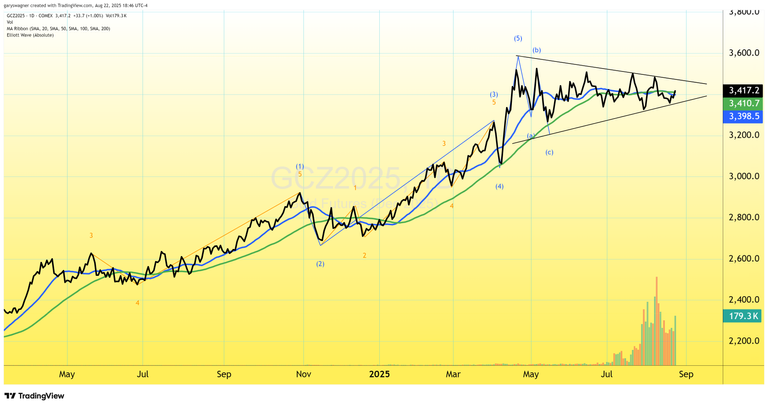Gold prices remained resilient on Monday, August 25, 2025, with spot gold trading at $3,372.67 per ounce as of 1:45 p.m. ET, holding near its two-week peak reached on August 11. December gold futures closed marginally lower at $3,417.50, down just 0.03%, reflecting the market's stability amid competing forces.

Federal Reserve Policy Drives Market Sentiment
The precious metal's current strength stems largely from monetary policy expectations. According to the CME FedWatch tool, markets are pricing in an 86% probability of a Federal Reserve rate cut in September—a substantial likelihood that reflects widespread anticipation of accommodative policy measures.
This high probability provides fundamental support for gold, as lower interest rates reduce the opportunity cost of holding non-yielding assets. The Federal Reserve's recent communications have signaled a potential shift toward more dovish monetary policy, reinforcing investor confidence in rate cuts ahead.
Dollar Strength Creates Headwinds
Despite supportive monetary policy expectations, gold's advance faces resistance from dollar strength. A stronger dollar makes gold more expensive for international buyers, naturally constraining demand and creating price resistance. This dynamic illustrates the complex relationship between currency movements and precious metal valuations, where policy support must contend with foreign exchange fluctuations.
Critical Data Ahead
Market attention now turns to Friday's Personal Consumption Expenditures (PCE) data release—the Federal Reserve's preferred inflation gauge. This report will provide crucial insights into the central bank's policy deliberations and could either reinforce current rate cut expectations or prompt a reassessment of the monetary policy trajectory.
Economic releases of this magnitude often trigger significant gold market volatility, as they directly influence the probability and timing of policy adjustments. Investors are positioning themselves for potential price movements based on how the inflation data aligns with Federal Reserve targets.
Global Supply Context
While monetary policy dominates current price action, gold operates within a global production framework. Continued mining operations worldwide, including facilities in regions like Krasnoyarsk, Russia, remind investors that supply-side factors also influence market dynamics. However, current price movements appear more driven by financial market sentiment than supply considerations.
Investment Implications
The current environment presents both opportunities and challenges for gold investors. Strong policy support suggests potential upside for gold positions, while currency volatility introduces timing considerations requiring careful analysis. The interplay between these factors creates a nuanced investment landscape that extends beyond simple policy expectations.
Market Outlook
Gold's steady performance near recent peaks reflects a market balancing supportive monetary policy expectations against currency headwinds. With rate cuts highly probable and critical inflation data approaching, the precious metal sector stands at a potentially significant inflection point.
The upcoming PCE release will likely determine whether gold can build upon recent gains or face renewed pressure from competing forces. The current market dynamics underscore gold's continued relevance as both an inflation hedge and monetary policy-sensitive asset, while highlighting the complex factors that determine precious metal valuations in modern financial markets.
As investors await policy clarity, gold's ability to maintain its position near recent highs suggests underlying strength that could translate into substantial gains if economic data supports current rate cut expectations. The precious metal remains well-positioned for potential advances, contingent on the realization of dovish Federal Reserve policy shifts.
For those that would like more information about our services click here
Wishing you as always good trading,

